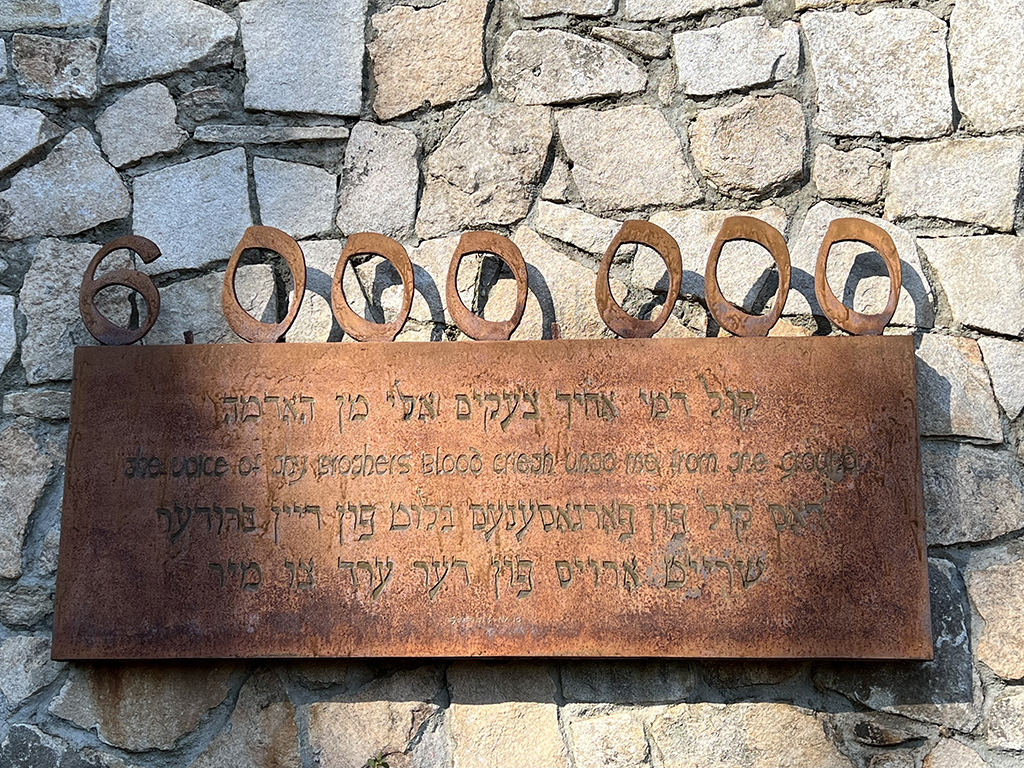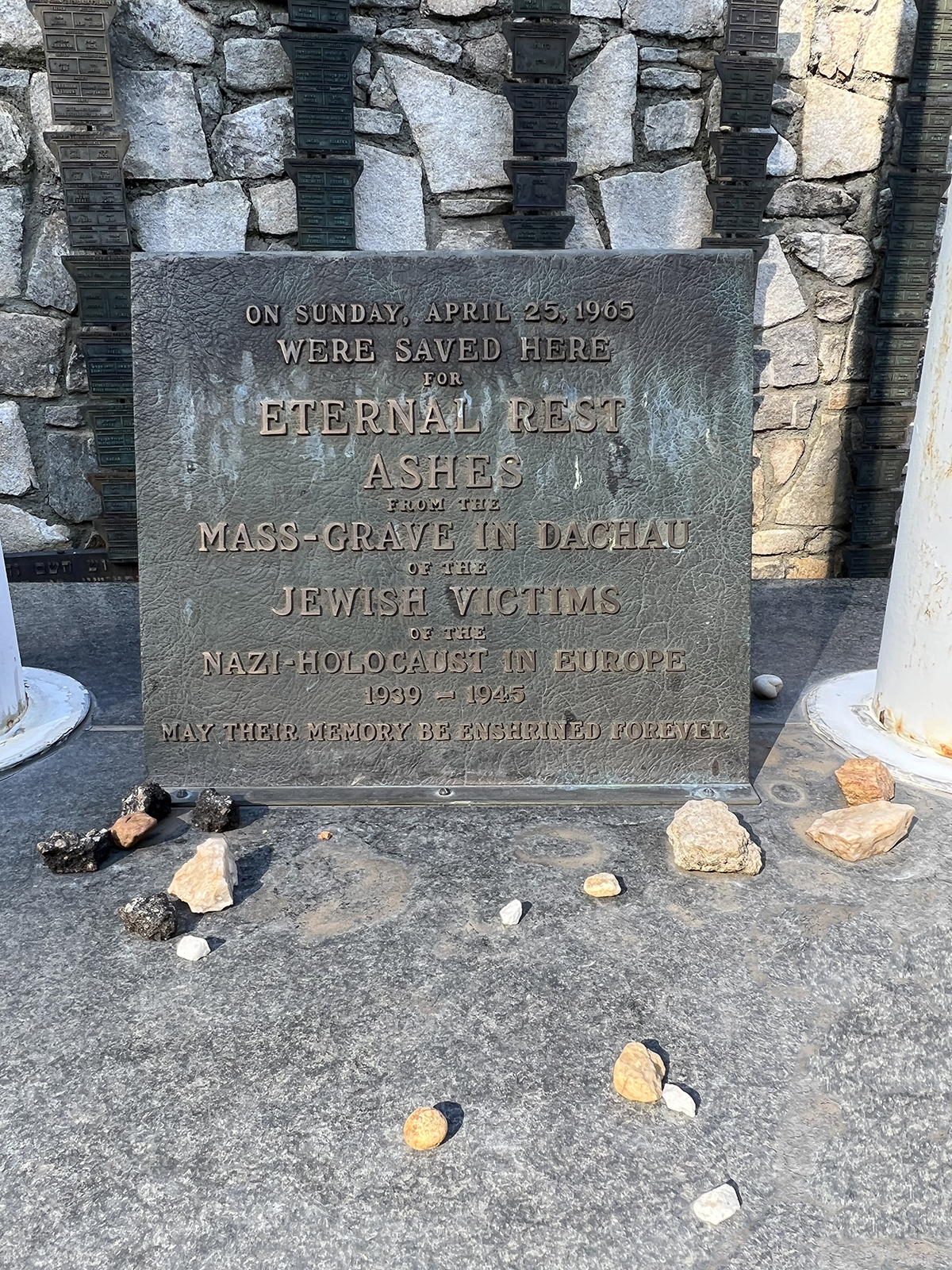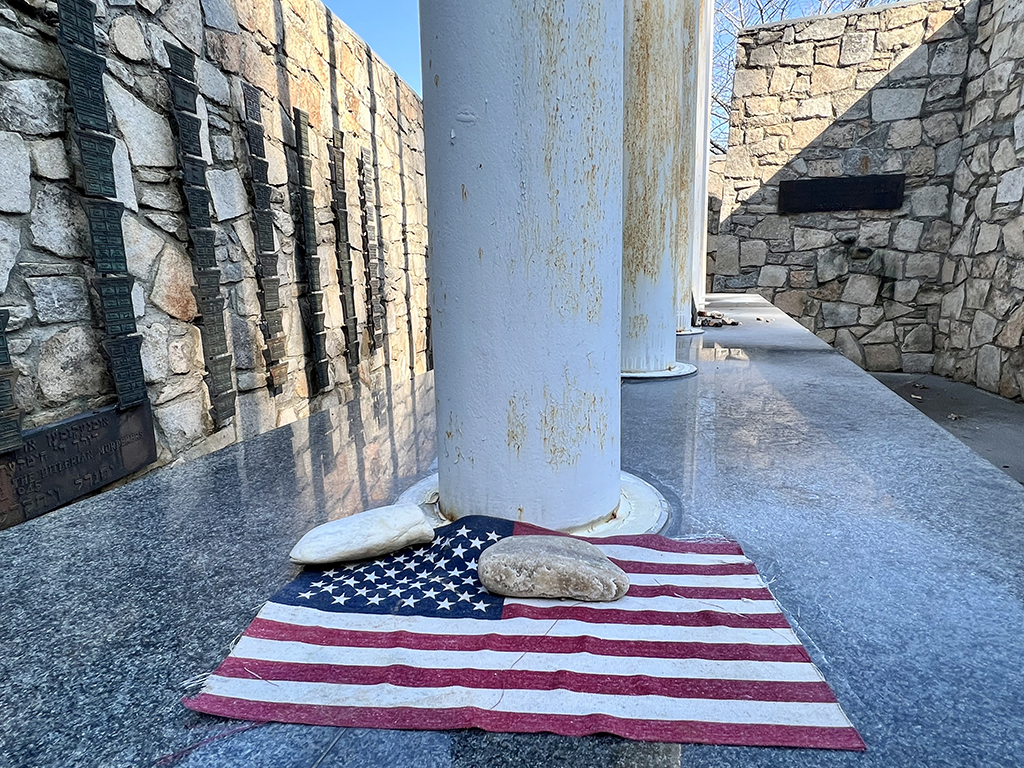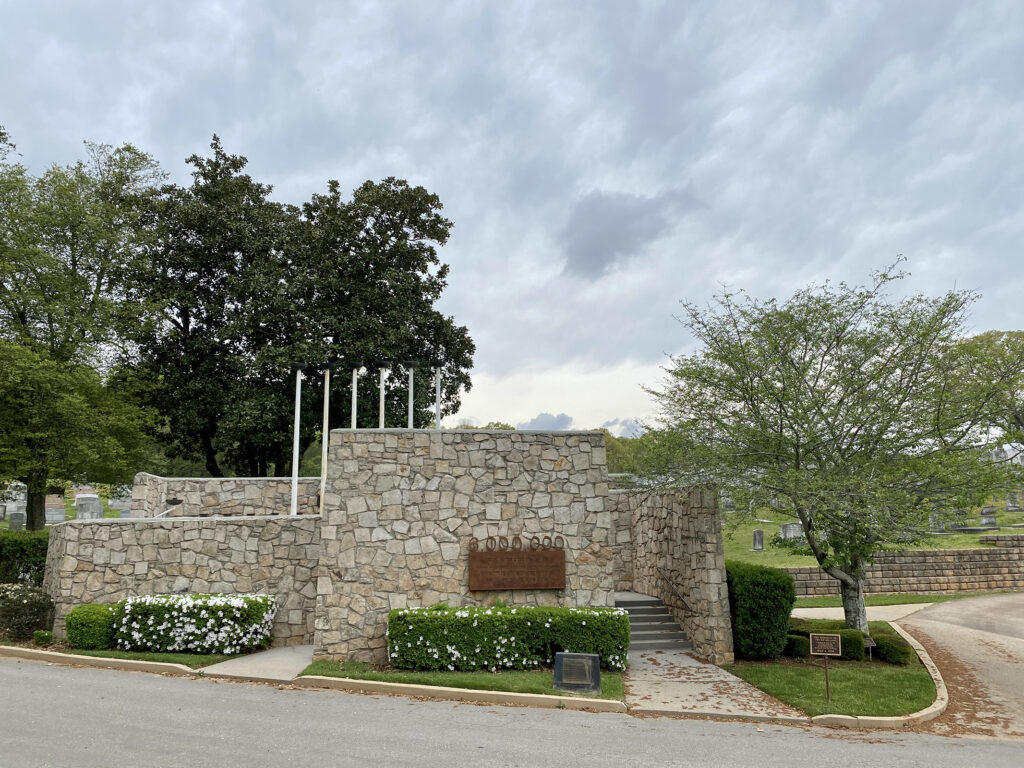
It was only a few years ago, while continuing to follow the Stone Mountain granite used in Atlanta’s infrastructure and many of its historic buildings—as well as many such structures beyond Atlanta, throughout Georgia, and across the nation—that I learned of the powerful Monument to the Six Million in Atlanta’s Greenwood Cemetery, the second such Holocaust memorial in the United States after Philadelphia's. It was very humbling not knowing sooner about this important memorial that's been at the center of yearly Holocaust remembrance ceremonies in my own city since its dedication in 1965, and which was even listed on the National Register of Historic Places in 2008. Each year, after Passover, the six white torches on the Monument to Six Million are lit during an official ceremony. To clarify, International Holocaust Remembrance Day is observed by many nations on January 27, and the Days of Remembrance are also commemorated in the United States in Spring.
I was surprised to find a Holocaust memorial constructed primarily of Stone Mountain granite, but after several visits and a good deal of research and reflection, I find the choice of stone absolutely brilliant and surmise it might even teach us something about the fate of the lamentable Confederate monument carved on Stone Mountain’s north face. No, of course it’s not uncommon to find tombstones and monuments made from local granite or marble, especially not in Georgia, but this monument’s designer, the late architect, author of three books, and Holocaust survivor, Benjamin Hirsch, intentionally used the donated Stone Mountain granite for a particular reason. For Hirsch, a recent Georgia Tech graduate just starting out as an architect in Atlanta at the time he drew up plans for the memorial in 1964, the rough granite symbolized the traumatic experience of the Holocaust. No smooth, finished marble would do, and Hirsch wanted to create "something more meaningful than a tombstone" that, with its four entrances, would "make the statement that it was open to the people of the four corners of the Earth."
Walking through the moving granite shrine to the 6,000,000 Jews murdered in the Holocaust, the stone walls actually felt charged with additional trauma to me—the lingering trauma of a natural monument having been defaced with a white supremacist carving in the first place and that caused by the Second Era Klan at Stone Mountain in decades past. After many years being immersed in Stone Mountain's history, I also couldn’t help thinking about Stone Mountain's profound and haunting connection to Atlanta's Jewish community, the 1915 lynching of Jewish factory superintendent Leo Frank by the Knights of Mary Phagan, which soon after renamed themselves the Knights of the Ku Klux Klan on top of Stone Mountain. The definitive book on this gripping chapter in Atlanta's history is And the Dead Shall Rise: The Murder of Mary Phagan and the Lynching of Leo Frank by Steve Oney.
As I continued researching the Monument to Six Million — which has sometimes been referred to over the years as the “Tombstone Monument," the “Monument to the Six Million Martyrs," or the "Memorial to the Six Million” — I also realized the major significance of it coming together in 1964. Dr. Marin Luther King, Jr. delivered his "I Have A Dream" speech on August 28, 1963, and by 1964, plans were already underway to turn Stone Mountain Park into a Confederate theme park and at last finish the carving on the mountain in direct opposition to the Civil Rights Movement. In 1964, the United Daughters of the Confederacy gifted the park a Confederate Flag Terrace, which was placed at the base of the mountain a few weeks after an annual national Klan rally at Stone Mountain and during a national United Daughters of the Confederacy convention held just a few weeks before the presidential election of 1964, the early days of Movement Conservatism. Bear in mind that these flags were also dedicated less than a year after Kennedy was assassinated in Dallas on November 22, 1963, when extremist, racist groups such as the Indignant White Citizens Council protested Kennedy's arrival carrying signs with Confederate flags on them. And recall that these Confederate flags were given to the park just months after Lieutenant Lemuel Penn was murdered by Klansmen in Madison County, GA on July 11, 1964, a little over a week after the Civil Rights Act of 1964 was passed. And this Confederate Flag Terrace was also dedicated at Stone Mountain Park the same month in 1964 that Dr. Martin Luther King, Jr. received word that he'd been awarded a Nobel Peace Prize. What a year indeed to design a Holocaust memorial to be built of granite rubble from Stone Mountain!
A write-up from the Southern Israelite on April 30, 1965, spotlighting the dedication of the Monument to Six Million really captured this mood:
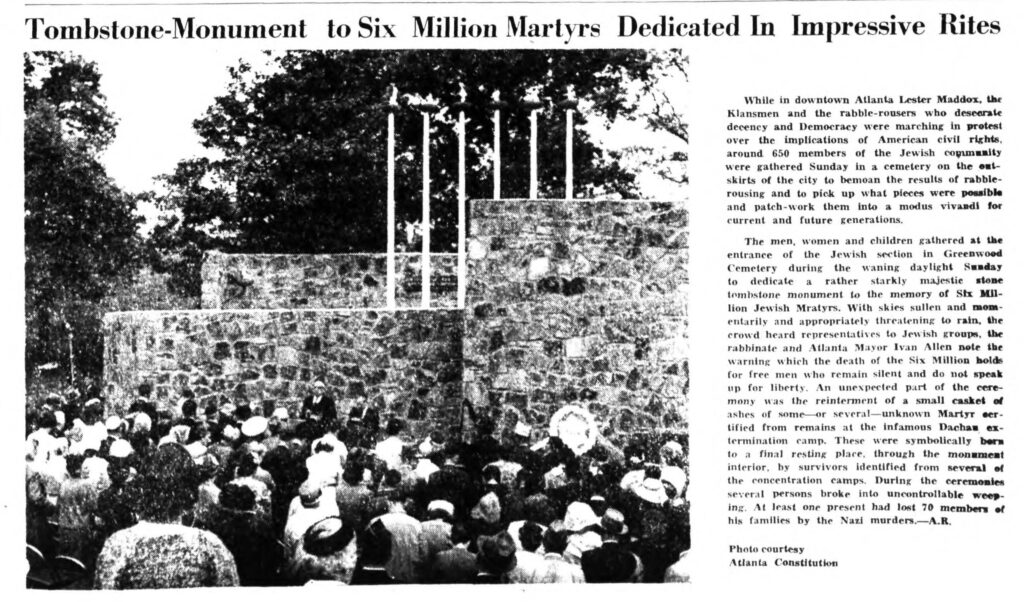
2022 marks 77 years since Auschwitz-Birkenau was liberated on January 27, 1945, and this year, the United Nations adopted a resolution not only officially condemning Holocaust denial but also praising countries "actively engaged in preserving those sites that served as Nazi death camps, concentration camps, forced labour camps, killing sites and prisons during the Holocaust, as well as similar places operated by Nazi-allied regimes, their accomplices or auxiliaries" and that "educate future generations." It may sound extreme, but I read that and again felt a chilling equivalency with the Confederate carving on Stone Mountain, the Klan, and other sites in America with complicated, and even atrocious, histories. In recent years I've paid special attention to news articles about old Nazi-era sites facing "redevelopment," particularly because of the many parallels with some former Klan-era sites in America, such as Stone Mountain. I also read Learning from the Germans: Race and the Memory of Evil by Susan Neiman a few years back to give my full attention to just how the United States can learn from the ways Germany has dealt with its Nazi-era monuments, flags, and sites in order to move forward. A quote from a 2018 article about the fate of former Gestapo headquarters in Germany really hit the nail on the head for me when it came to my concerns about the Stone Mountain Memorial Association's (SMMA) proposed plans for a "Confederate Valor Park" and a truth-telling exhibit about the Confederate carving: "The developer has proposed an offensively minimal commemoration of the building’s extremely dark history." I would not want such minimization to occur when telling the truth about the carving or the park's darkest chapters.
Last year, just when I was feeling optimistic that the Confederate Flag Terrace at the base of the walk-up trail on Stone Mountain would finally be removed after 57 years, it dawned on me that the plans for its relocation were even more ridiculous and would place the flags in an even more dramatic context. The SMMA envisions a new 40-acre area just beneath the Confederate carving called "Confederate Valor Park," which many rightfully worry will create a photo opp for park visitors that will actually capture both the flags and the carving in one image. Imagine the social media ramifications of that. There's even talk of creating a "designated area" at Stone Mountain Park just for "Confederate sympathizers." Like a smoking area...or, can you imagine, a "Nazi sympathizer" area? What a mixed message that would send while simultaneously planning to tell the truth about the Confederate carving.
I say it all the time; this mountain is a beautiful gift of nature, and the park is one of the state's greatest and most popular. We truly must be brave enough to draw the line when it comes to glorifying Confederate monuments in any way. Let's set things right for future generations and do something unbelievably beautiful for this mountain we reclaim for ALL, even if it means preserving something as odious as the carving for educational purposes. "Never again" has to really mean "never again." The process won't be easy and will take time and may be very uncomfortable in the short term—but a great teaching opportunity is before us, and with that will come great healing and future peace. I remain steadfastly in favor of the truth as long as it's the unvarnished truth. I think it would even serve us all well to tour the permanent "Absence of Humanity" exhibition that the prolific Benjamin Hirsch designed in 1996 for The William Breman Jewish Museum to see how even the most difficult subjects and painful atrocities can be thoughtfully presented.
FURTHER READING
- “Survivors of Nazism: To Erect Monument in Atlanta For Six Million Jewish Martyrs” (Southern Israelite, 7/24/1964)
- “Monument for Six Million Victims To Be Erected in ‘Garden of Martyrs’” (Southern Israelite, 10/16/1964)
- “Ground Broken for Atlanta Monument To Memory of Six Million Martyrs” (Southern Israelite, 3/05/1965)
- “Monument Here Will Honor Jewish Victims of Nazis” (Atlanta Constitution, 4/16/1965)
- “Atlantans to Honor Victims of Nazis” (Atlanta Constitution, 4/24/1965)
- “Tombstone-Monument to Six Million Martyrs Dedicated In Impressive Rites” (Southern Israelite, 4/30/1965)
- “Service Tomorrow Honors Slain Jews” (Atlanta Constitution, 5/06/1967)
- “Services Will Honor 6 Million Victims of Nazis” (Atlanta Constitution, 4/20/1968)
- “Prize Winning Architectural Design” (Southern Israelite, 8/23/1968)
- “Atlantans to Reflect On Horrors of Nazism” (Atlanta Constitution, 4/13/1969)
- “Jewish Ceremony Here Recalls Nazi Horror” (Atlanta Constitution, 3/02/1970)
- “Courses Teach People To Not Forget Horrors Of Holocaust” (Atlanta Constitution, 5/06/1978)
- “Architect Leaves His Mark” (Southern Israelite, 3/21/1980)
- “Survivors Recall The Holocaust, Nazi Horrors Burn In Jewish Memories” (Atlanta Constitution, 4/10/1980)
- “The Art Of Remembering” / “Life Before, After The Holocaust” (Atlanta Constitution, 6/30/1996)
- “New Memoir By Holocaust Survivor Reflects Hope and Humor Amid Despair and Death” (Atlanta Constitution, 7/17/2000)
- “Bizarre Burial Prods Holocaust Angst” (Atlanta Constitution, 9/25/2000)
- Georgia. Historic Preservation Division (05/2008)
- Georgia. Dept. of Natural Resources. Historic Preservation Division (04/2010)
- Benjamin Hirsch Obituary (Atlanta Constitution, 2/13/2018)
- Benjamin Hirsch authored three books about his Holocaust experiences: Hearing a Different Drummer (2000), Home Is Where You Find It, and In Search of Validation (2020, posthumously)

